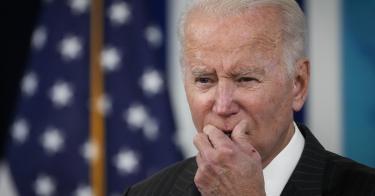My 1980 high school yearbook was a sign of the times. Inside was a picture of a massive billboard opposite the home of the 82nd Airborne Division on Fort Bragg Boulevard. Its message encapsulated the legacy of the Jimmy Carter presidency: “Iran, Let Our People Go.”
That is what we had become: a mendicant begging Tehran’s theocratic fanatics to release American diplomats and soldiers.
In the 1970s, the world assumed the United States was on an inevitable decline riven by problems at home and indecisiveness abroad. The Soviets invaded Afghanistan, and Cuban proxies were rampaging through southern Africa. The defense budget tanked. There was no fuel for vehicles and no money for training, and the carriers were stuck in port.
The Carter years have returned with a vengeance. It did not take the Biden administration long to signal American weakness. With China continuing its massive military modernization program and increasingly threatening its neighbors, the administration opted to open the government spending spigot, while defense and homeland security were set to receive a few extra droplets. In case any world leader failed to pick up on that clue, the administration followed with the debacle in Afghanistan.
>>> Why Is Defense Authorization Bill Languishing in Senate?
In underfunding the Pentagon, Biden has stolen a page not just from President Jimmy Carter but from the Obama playbook, too. During the Obama administration, ships and crews were worn out, several Air Force fighter squadrons were grounded due to lack of funding, and bureaucratic initiatives arrested the development of a generation of promising sailors and pilots. Future systems were also put on hold.
With the return of Carter-era inflation, President Joe Biden’s defense spending remains anemic compared to the multiple great power threats we face. The Pentagon was already projecting an inflation rate of 2.2 percent before inflation kicked into gear, with the Federal Reserve now predicting a 4.2 percent annual rate for 2021. The Biden administration requested a 1.6 percent increase to the defense budget.
The difference today is that communist China is a more formidable threat than the sclerotic Soviet empire was at its height. And China has junior partners in crime in Moscow, Tehran and Pyongyang.
The American military now faces a ferocious great power competition without the resources to match the threat. The claxons are sounding. The Heritage Foundation’s “2022 Index of U.S. Military Strength” has laid open the looming threat: “In the aggregate, the United States’ military posture continues to be rated ‘marginal.’ "
The 2022 index concludes that our current force is likely capable of meeting the demands of a single, major regional conflict while also attending to presence and minor engagement activities elsewhere. But our military would be ill-equipped to handle two major regional conflicts at once — especially considering the generally weak condition of key military allies in Europe and the Pacific.
The U.S. military is getting older faster than it is getting modern. As currently postured, the index concludes that “the U.S. military continues to be only marginally able to meet the demands of defending America’s vital national interests.”
The crisis is most evident in the Pacific, and the annual defense report on China from 2020 makes clear the U.S. is losing on shipbuilding. China has over 110 large shipyards; we have 20 capable of building the Navy’s large warships — only four actively doing this. China can now put 350 combat ships at sea; we can’t get near 300. According to the Congressional Budget Office, the maintenance required on our submarine fleet alone would occupy the resources of all our shipyards for the next 30 years.
The United States Air Force is looking at facing China’s arriving fifth-generation fighters with small numbers of F-35s, but mostly aged F-15s and F-16s that will not survive in a high-end conflict.
When laser focus is required to deter China and Russia, billions of dollars are being siphoned off the Pentagon top line “to mitigate the impacts of climate change.” No doubt that’s pleasing to Adm. Greta Thunberg, but it won’t impress Chinese President Xi Jinping.
What will prove impressive is deterrence. We know it works. China is not invincible; it has structural, ideological and geographic vulnerabilities that can be exploited by a vigorous America.
>>> America Needs a Grand Strategy
But time is running out. We must act now: Invest in new weapons, divest legacy systems as the new ones come online, and harden our space and cyber assets. We must also unleash Silicon Valley to condense the kill chain by turning artificial intelligence on the Chinese to overwhelm their systems.
While Jimmy Carter bungled Iran, he got it right when he said that the Soviet invasion of Afghanistan revealed what was at the heart of Moscow’s ambitions. He immediately put in train production of the B-1 bomber, the Abrams tank and the Minuteman 3 intercontinental ballistic missile — systems President Ronald Reagan would build upon to confront the Kremlin.
One can only hope that President Biden, having bungled Afghanistan, will have a similar epiphany regarding China and help the Pentagon “Build Back Better.” Otherwise, we may see unsettling billboards on Bragg Boulevard in the next three years.
This piece originally appeared in Defense News



